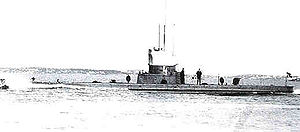
The Kriegsmarine was the navy of Nazi Germany from 1935 to 1945. It superseded the Imperial German Navy of the German Empire (1871–1918) and the inter-war Reichsmarine (1919–1935) of the Weimar Republic. The Kriegsmarine was one of three official branches, along with the Heer and the Luftwaffe of the Wehrmacht, the German armed forces from 1933 to 1945.

The C class was a group of twenty-eight light cruisers of the Royal Navy, and were built in a sequence of seven groups known as the Caroline class, the Calliope class, the Cambrian class, the Centaur class, the Caledon class, the Ceres class and the Carlisle class. They were built for the rough conditions of the North Sea, and proved to be rugged and capable vessels, despite their being somewhat small and cramped.
The German operation for the invasion of Denmark and Norway in April 1940 was code-named Weserübung, or "Weser Exercise." Opposing the invasion were the partially mobilized Norwegian military, and an allied expeditionary force composed of British, French, and Free Polish formations. The following list formed the order of battle for this campaign.
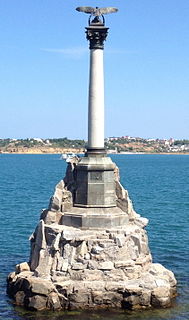
Scuttling is the deliberate sinking of a ship by allowing water to flow into the hull. This can be achieved in several ways—seacocks or hatches can be opened to the sea, or holes may be ripped into the hull with brute force or with explosives. Scuttling may be performed to dispose of an abandoned, old, or captured vessel; to prevent the vessel from becoming a navigation hazard; as an act of self-destruction to prevent the ship from being captured by an enemy force ; as a blockship to restrict navigation through a channel or within a harbor; to provide an artificial reef for divers and marine life; or to alter the flow of rivers.

SM U-151 or SM Unterseeboot 151 was a World War I U-boat of the Imperial German Navy, constructed by Reiherstieg Schiffswerfte & Maschinenfabrik at Hamburg and launched on 4 April 1917. From 1917 until the Armistice in November 1918 she was part of the U-Kreuzer Flotilla, and was responsible for 34 ships sunk and 7 ships damaged.

The B-class submarines were a class of six vessels of the US L class built on licence at Karljohansvern naval shipyard in Horten, Norway from 1922 to 1929 and deployed by the Royal Norwegian Navy.

HNoMS Draug was the lead ship of the three-ship Draug class of destroyers built for the Royal Norwegian Navy in the years 1908–1913. The four-stacked destroyer was kept in service long after she was obsolete, and took part in the defence of Norway during the German invasion in 1940.
HNoMS Tyr was a Gor-class Rendel gunboat built for the Royal Norwegian Navy at Karljohansverns Verft Naval Yard in Horten. She was laid down in 1884 and launched in 1887 with build number 67. Tyr was one of a class of two gunboats - the other ship in her class being HNoMS Gor. Gor and Tyr can be seen as improved Vale-class gunboats, of 290 tons instead of the 250 tons standard for that class.
SM U-156 was a German Type U 151 U-boat commissioned in 1917 for the Imperial German Navy. From 1917 until her disappearance in September 1918 she was part of the U‑Kreuzer Flotilla, and was responsible for sinking 44 ships and damaging three others, including a warship. She took part in the Attack on Orleans.

HMS Sea Nymph was a S-class submarine of the third batch built for the Royal Navy during World War II. Completed in July 1942, she spent the majority of her career patrolling the waters off Norway in the North Sea, then was sent to the Pacific but was forced back due to technical problems.
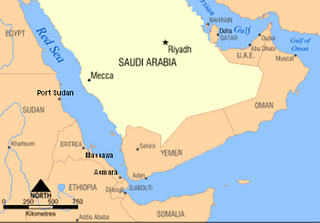
The Red Sea Flotilla was part of the Regia Marina Italia based at Massawa in the colony of Italian Eritrea, part of Italian East Africa. In World War II, the Red Sea Flotilla was active against the East Indies Station of the Royal Navy, from the Italian declaration of war on 10 June 1940 until the fall of Massawa on 8 April 1941.

The Redoutable-class submarines were a group of 31 submarines built between 1924 and 1937 for the French Navy. Most of the class saw service during the Second World War. The class is also known in French as the Classe 1 500 tonnes, and they were designated as "First Class submarines", or "large submarine cruisers". They are known as the Redoutable class in reference to the lead boat Redoutable, in service from 1931 to 1942. The class is divided into two sub-class series, Type I, known as Le Redoutable and Type II, Pascal.
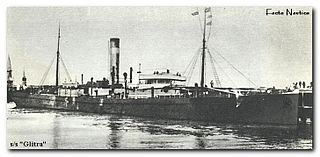
SS Glitra was a steam ship that was the first British merchant vessel to be sunk by a German submarine in the First World War.

The CB-class was a group of midget submarines built for the Italian Navy during World War II. However, they were also used by several other navies, seeing action in the Mediterranean and in the Black Sea.
Luigi Torelli was a Marconi-class submarine of the Italian navy during World War II. The vessel operated in the Atlantic from September 1940 until mid-1943, then was sent to the Far East. After Italy's surrender in 1943, the Torelli was taken over by Nazi Germany's Kriegsmarine, then, in the waning months of the war, the Japanese Imperial Navy. It was one of only two ships to serve in all three major Axis navies, the other being the Italian submarine Comandante Cappellini.
HNoMS Tor was a Sleipner-class destroyer of the Royal Norwegian Navy that was launched in September 1939. She was under outfitting and testing when Nazi Germany invaded Norway on 9 April 1940. Although scuttled by Norwegian naval personnel to prevent her from being captured by the invading forces, she was soon salvaged by the Germans and put into service with the Kriegsmarine. Under the name Tiger she served out the war as an escort and training vessel, being recovered by the Norwegians in Denmark after the German capitulation in 1945. After the war she was converted to a frigate and served until 1959.
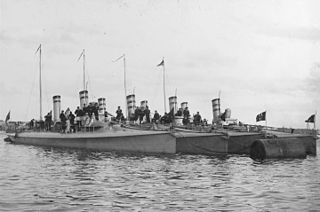
HNoMS Brand was a 1.-class torpedo boat constructed in 1898. She served the Royal Norwegian Navy for more than four decades, including neutrality protection duties during the First World War. Having once again been employed on neutrality protection duty at the outbreak of the Second World War, Brand was captured by the Germans during their invasion of Norway in April 1940.

Håkon Nilsen, Stavanger, Norway, popularly known as "Torpedo Nilsen", was a Norwegian war veteran and highly decorated allied naval torpedo commander of World War II.
